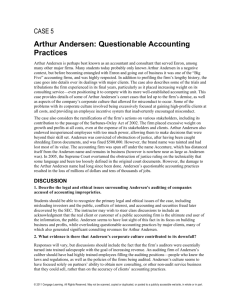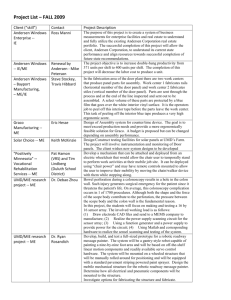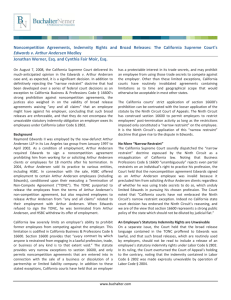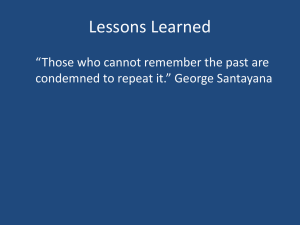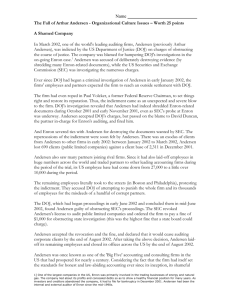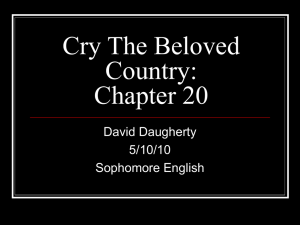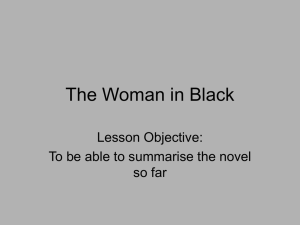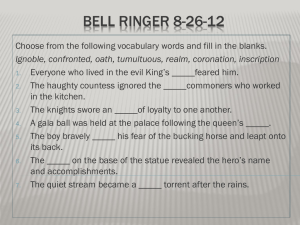AA - Email - University of Exeter
advertisement
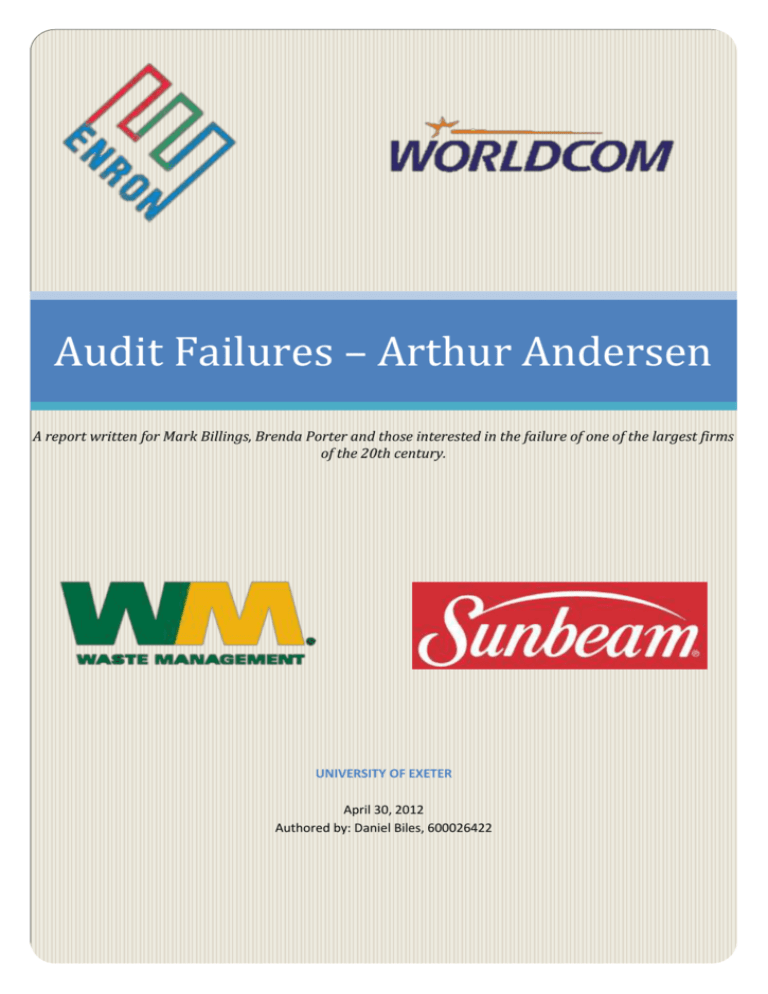
Audit Failures – Arthur Andersen A report written for Mark Billings, Brenda Porter and those interested in the failure of one of the largest firms of the 20th century. UNIVERSITY OF EXETER April 30, 2012 Authored by: Daniel Biles, 600026422 Executive Summary In a small report such as this one, it is impossible to cover all of the reasons why Arthur Andersen LLP failed in its duties to the public and ceased to be the largest of the ‘Big 5’ accounting firms. Here, the practice of document shredding is examined with reference to the collapse of Enron in particular. The loss of independence due to a rapid expansion and increase in services is suggested to be a factor, as well as the deterioration of the business culture in general. Contents 1. Introduction……………………………………………………….………………….2 2. Audit Failures………………………………………………………………………...2 2.1 Document Shredding…………………………………………………...………….2 2.2 Priorities – Keeping Clients vs. Independence……………………………..…….3 2.3 Business Culture……………………………………………………………….…..4 3. Conclusion…………………………………………………………………………….5 4. References…………………………………………………………………………….6 1 “We believe in integrity, respect and always speaking as one firm. We believe in maintaining a passion for excellence in people, service and innovation. And we believe in demonstrating a commitment to personal growth through training and development. In fact, these values are minimum standards for anyone within our organization. Each has roots in the thinking of Arthur Andersen himself. And each guides us toward a brighter future ahead.” Arthur Andersen LLP value statement (pre 2002) [1] [2] 1. Introduction Arthur Andersen LLP (AA) was once known as a company whose core, most important value was integrity. Arthur Andersen himself only stood for the highest of standards, strongly believing that his sole responsibility was ensuring investors received accurate information. In later years, it seems that this integrity and focus was replaced by a need to please corporate management, to ensure that AA’s lucrative services (including non-audit services) were retained by satisfied companies with high (reported) profits. As a result of this loss of independence (and with hindsight, fairly predictably) AA was accused of undertaking fraudulent audit services for companies such as WorldCom, Enron, Sunbeam-Oster, Waste Management Inc, amongst others. AA was seen as a company ‘too big to fail,’ it was one of the ‘Big 5’ accounting firms, yet these accusations proved to be the catalyst for huge changes to the audit profession and inescapable repercussions for AA. This report will look at how and why these practices were performed, undetected, for so many years and for so many companies. 2. Audit Failures 2.1. Document Shredding Before the collapse of Enron, there were clear indications of impending trouble, and when the Securities and Exchange Commission (SEC) began an informal investigation, Dave Duncan (the engagement partner for Enron) was reminded of AA’s new document handling policy. (This policy allowed ‘secondary’ documentation to be destroyed, i.e. anything not supporting the audit opinion, in case of impending litigation. It had been created a year and a half previously and, according to various documentaries and reports, was used on a smaller scale 2 in other cases such as Sunbeam-Oster).[3] In the Enron case, AA continued destroying documents even after the SEC had requested accounting records for Enron, and only ceased this practice after a subpoena was issued. Before the subpoena, almost two tons of paper was destroyed, along with 30,000 emails and computer files. This document shredding was a significant factor in AA’s subsequent indictment for ‘obstructing an official proceeding of the SEC.’ [4] In the UK now, ‘ISA 230: Audit Documentation’ requires adequate documentation to provide evidence of the audit opinion and reasons for it, and that the audit was conducted in accordance with ISA’s and relevant laws/regulations. As a direct response to AA’s practices, ISA 230 also includes a section requiring a timely (within 60 days) assembly of the final audit file (a process involving the deletion of redundant documentation, documenting any relevant information not already recorded and signed off on completion checklists etc.). After this the auditor is not permitted to get rid of any documentation before the applicable retention period (usually 6 years). [5]Also the Sarbanes-Oxley Act enabled punishment of anyone who alters, destroys, conceals etc. any document with the intent to influence any investigation. Clearly, the shredding of documents at AA has had lasting effects on the audit profession and there has been no notable repeat, largely due to the new regulations enacted. Whilst there was no specific law preventing the destruction of these ‘secondary’ documents, it has been suggested that in the Enron case, the SEC investigation was foreseeable and therefore the document shredding was against the law. However, foreseeable or not, such a large scale operation should surely have sent alarm bells ringing much earlier than it did. 2.2 Priorities – Keeping Clients vs. Independence Auditors are required to be objective (offering opinions without bias, compromise and conflicts of interest) and independent, both in mind (acting with integrity, objectivity and scepticism) and in appearance (where a reasonably informed third party would not conclude that independence has been compromised). As stated previously, Arthur Andersen would not tolerate a compromise of his high standards of independence. Soon after AA’s formation, he refused to sign off on a large rail company’s incorrect accounts, despite the possibility of 3 losing a major client, and this is what is expected from all auditors in similar situations. [6] However, with the expansion of the business, and increasing pressure on generating revenue, the main objective switched to making sure that clients (and more importantly, revenue) were retained. Clients scared of the repercussions of losing an auditor, such as a poor reputation and falling stock price, experienced a shift to an environment where they could dictate their needs to auditors who were scared of losing their custom. Independence may have been compromised by the offering of non-audit services. However, this dual role of an auditor compromises independence in 4 ways. Firstly, a self-interest threat may arise due to the high non-audit fees, and the auditor’s reluctance to lose the client. A self-review threat may also arise if the auditor audits, for example, an internal control system which they had consulted on. A management threat arises if the auditor makes decisions on behalf of the management, and can cast doubt over the distinction between client and auditor. Finally, an advocacy threat could arise as the auditor supports the client’s views/position. [5] At AA, the most prominent seemed to be the self-interest threat, as a result of top management requiring revenue as a bottom line performance measure. Until 1989, the Andersen Consulting arm of the business (now Accenture) contributed 40% of AA’s revenue. The Sarbanes-Oxley Act, as a consequence, specified prohibited practices to restrict the nonaudit fees received by firms. 2.3 Business Culture AA’s value statement claimed that the heart of the business was integrity, as its founder had wanted. However, before its ‘near death,’ the culture of the business seemed to have completely changed. Starting with recruitment, the focus was seemingly on graduates who would adapt to and follow the rules, rather than those who would challenge what they thought was wrong. [3] [6] Rather than for personal and professional development, training was seen as a way to ensure everyone conformed to the same approach (a fair motive for a company with good business practices as AA once had, but in this case, as has been highlighted, this may have just turned into the blind following of poor instructions). 4 In most large businesses, employees are able to thrive in a competitive atmosphere, ensuring everyone is performing at a high standard. At AA, it has been suggested that social psychological theories (including obedience under authority and loss of identity in crowds) may have had an influence on employee behaviour. [7] [8]Would these employees have mindlessly signed off on clearly misleading statements, or commenced shredding countless working papers, if they were willing to challenge their management, or if they had to make the decision themselves? In this sense, the ‘speak as one firm’ part of the value statement was satisfied, in a twisted and unintended way. Perhaps a minority believed in what was happening, but it would be extremely disturbing if everyone at AA thought what was happening was right for the business, the shareholders and stakeholders of the companies who they were supposed to protect. 3. Conclusion The above value statement has a clear focus on being trustworthy, providing excellent service, developing employees and following the ideals of Arthur Andersen. Strangely it could be argued that most of these had been worked towards. There was certainly a view from the outside of integrity, of respect, and the firm did speak as one. The service was seen as top quality, resulting in AA becoming the largest of the Big Five. Training was seen as essential, and employees were forced to move ‘up or out.’ This was how the picture was painted to the outside, and with a thin layer of truth, no-one dug deeper to find the mess behind. Arthur Andersen’s key ideas were represented, but they were blurred, and perhaps an afterthought to the desire to be competitive, to keep clients happy, and to create revenue for a ship that was, supposedly, too big to sink. 5 4. References [5] Porter, B. Simon, J. Hatherly, D. (2008) Principles of External Auditing, 3rd edition, Chichester: John Wiley & Sons, Ltd. [1] Waygood, T. Bringing Values to Life. Available: www.dixeyhenderson.com/downloads/motivaction.pdf. [23 Mar 2012] [2] Lemanski, T. (2011) The Role of Core Values in Business Strategy and Leadership. Available: www.vista-development.com/ws/core_values.htm. [23 Mar 2012] [4] Kinsler, J. (2008) Arthur Andersen and the Temple of Doom. Available: www.swlaw.edu/pdfs/lr/37_1kinsler.pdf. [29 Mar 2012] [3] Squires, S. Smith, C. McDougall, L. Yeack, W. (2003) Inside Arthur Andersen: Shifting Values, Unexpected Consequences. Financial Times (Prentice Hall) [6] Vaz, B. Arthur Andersen - The Giant’s Fall. Available: www bcvaz.in/vision/arthur_andersen.htm. [4 Apr 2012] [7] WUSTL. (2003) Deep psychological contracts formed between employees and employers can result in acts of revenge, ‘crimes of obedience.’ Available: news.wustl.edu/news/Pages/114.aspx [5 Apr 2012] [8] Buttross, T. Schmelzle, G. Rao, H. (2011) Ethical Decision Making by Management Accountants: An Empirical Examination of Obedience Theory. Available: papers.ssrn.com/sol3/papers.cfm?abstract_id=1787613 [5 Apr 2012] 6
